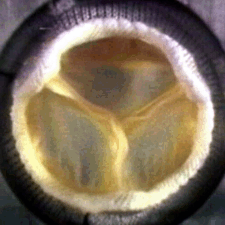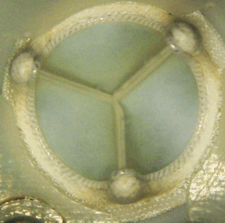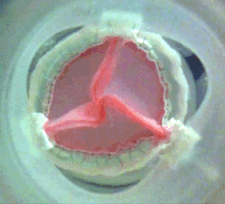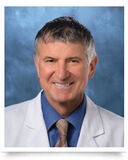“How Do Tissue Heart Valve Replacements Open And Close?” Asks Mary Anne
By Adam Pick on March 23, 2010
I just received a great question from Mary Anne about heart valve anatomy. Specifically, she is interested to learn more about valvular function within the heart.
Mary Anne writes, “Dear Adam – I was recently diagnosed with severe mitral regurgitation. As an active 67-year old grandmother, this has been a difficult time – especially since I’m asymptomatic. However, my heart is already dilated so I’m preparing for surgery. Quick question… If the surgeon can’t repair the valve, I’m thinking about a tissue valve replacement. Do you have any videos that show how tissue heart valves open-and-close? Thanks, Mary Anne”
So you know, I had this exact question prior to my aortic valve replacement surgery. I remember thinking, “How do heart valves replacements work? How do the heart valve leaflets seal?”
To answer those questions, I located three videos (shown below) which illustrate exactly how tissue valve replacements open-and-close. Here is a video of a tissue heart valve replacement made from the leaflets of a pig (also known as a porcine valve).

Here is a video of a valve replacement made from the pericardial tissue of a cow’s heart (Edwards Perimount):

Here is the video of the stentless valve replacement we discussed yesterday – the ATS 3f Aortic Bioprosthesis.

I hope this helps Mary Anne (and perhaps you) visually understand how the leaflets of tissue heart valve replacements open and close.
Keep on tickin!
Adam
|
jerry says on March 23rd, 2010 at 12:34 pm |
|
I wonder if she is asking what makes them open and close since there will be no nerves to tell them to open and close. The answer is that it is purely a mechanical function of the way the valve is designed to act in the ebbing and flowing tide/pulse of the blood flowing through it, which your home movies up above show quite nicely. (That is the answer, right?) |
 |
|
Patricia Shabel says on March 23rd, 2010 at 3:39 pm |
|
Mary Anne, I had severe mitral valve regurgitation and was fully symptomatic and in really bad health. My surgeon, Dr. Alfredo Trento at Cedars Sinai Hospital in Los Angeles, did a fabulous repair with the DaVinci robotic minimally invasive method on December 15th, 2009, and I have to say I am SO HAPPY with the results! I went on 5 roller coasters on Saturday and felt great! I have a normal heartbeat and absolutely NO symptoms! With all of the technology that is available today around repairing mitral valves, I would highly recommend exhausting that option first. There are little to no complications with repair whereas there can be many more complications with replacement of the valve, because they are introducing this foreign valve into the body so there can be issues with that. I will most likely NEVER have to do anything else with this valve ever again, because it was repaired. If I had had it replaced, the valve replacement only lasts approximately 10 years or so, depending on the type of valve. I don’t know about you, but I don’t want to have to go through this again if I can avoid it, and repairing the valve is the way to avoid it based on all of the research I did about valves through Adam’s book to Cleveland Clinic to other studies and info I found on the web. The Cleveland Clinic, my surgeon, and many of the doctors suggested on Adam’s site not only prefer repair but are committed to it and insist on it. Even though you are 67 years old and especially since you are very active, I would again suggest you really exhaust your options with repair and minimally invasive procedures. They seem to be the best option for quick recovery and for being done with this for the long haul. I hope this helps! |
 |
|
Michelle says on March 23rd, 2010 at 6:58 pm |
|
Hi Mary Anne- On 2/11/10 I underwent a mitral valve replacement with a porcine valve and a maze procedure at the Cleveland Clinic. Going into the surgery, I was aware that a minimally invasive procedure would not be possible due to previous open heart surgery I had at age 4 to correct a left anomalous coronary artery (a congenital defect). Although my cardiologists and surgeon had hoped for a mitral valve repair, the valve was not repairable. Like yours, my valve was also regurgitating severely and the left atrium was grossly enlarged. My primary symptom was an increase atrial fibrillation. The doctors’ diagnosis did not come as a total surprise. At age 13, it was anticipated that my mitral valve would require replacement by the time I reached age 21. To my fortune, I exceeded that by 30 years! I have been amazed at my rapid recovery. Initially, each day I was monumentally better than the prior one. In the first 2 weeks it was beneficial to rely on the prescribed pain medications to get up, to move around and to sleep comfortably. Controlling the pain aided my recovery and healing. By week 5, I walked 3 1/2 miles. I had a full sternectomy and the incision has been fully healed for 2 weeks. Being active prior to surgery will surely be a plus for you. From my experiences, I would like to share a few suggestions: Find a surgeon/hospital that is skilled in mitral valve repair. But keep in mind that you should have a back up plan just in case a repair is not possible. I was very indecisive about my back up plan. The evening before surgery I finally decided on a tissue valve as my back up. The thought of taking anticoagulates the rest of my life detered me from choosing a mechanical valve. In addition, I was reminded that the technology for valve replacements is advancing rapidly and replacements may not be require open heart surgery in 10-15 years when I may need to address another replacement. Be well-informed going into the surgery. Adam’s book and blog have been a great source of information. I also found Cleveland Clinic’s website informative. It was helpful to schedule my surgery as soon as possible. The waiting game was tough with lots of emotional meltdowns. The Cleveland Clinic recommended the use of guided imagery for 2 weeks prior to surgery. I downloaded a program onto my MP3 player and used it faithfully. I believe this relaxation program helped me to calmly approach my surgery and it has helped in the overall healing process. Faith in your surgeon and medical team are important. Dr. Pettersson at CC was my surgeon. I knew that I was in gifted hands. I thought that if he can do a heart and lung transplant, then a valve job must be an easy task for him. My cardiologists described him as one of the best surgeons in the world. Remember the pain is temporary. The pain was not as bad as I had anticipated it would be and the worst of it was over in a few days. Pain management was greatly stressed by the nursing staff. The first few days post-op you will feel pretty wiped out and not very independent. This was humbling to me as I am usually the helper. You’ll will find renewed strength day by day. One last suggestion, avoid eating a heavy meal the night before your surgery. My husband and I decided to celebrate with a romantic dinner the night prior to my surgery. Big mistake– the abdominal bloating relating to an inactive gut (anesthesia and pain meds) and constant heartburn, just added to my misery the first few days. I am looking forward to returning to my job as a speech pathologist in a skilled nursing facility next week (6 1/2 weeks after my surgery)! I have decided to ease into it by working part-time for the first 2 weeks. Good luck in your heart adventure. May God bless you and comfort you. |
 |
|
Adam Pick says on March 23rd, 2010 at 7:06 pm |
|
Michelle, Thanks for taking the time to share your very thoughtful ideas, tips and support for Mary Anne! Great to hear your surgery with Dr. Pettersson went so well. Keep on tickin! Adam |
 |
|
Andrew Wrigley says on March 24th, 2010 at 5:34 am |
|
As I have a mechanical valve, are there any videos of the mechanical valves…? Mitral valve, please. |
 |










